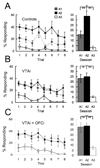How do you (estimate you will) like them apples? Integration as a defining trait of orbitofrontal function
- PMID: 20206497
- PMCID: PMC2862846
- DOI: 10.1016/j.conb.2010.01.009
How do you (estimate you will) like them apples? Integration as a defining trait of orbitofrontal function
Abstract
The past 15 years have seen a rapid increase in our understanding of orbitofrontal function. Today this region is the focus of an enormous amount of research, including work on such complex phenomena as regret, ambiguity, and willingness to pay. The orbitofrontal cortex is also credited as a major player in a host of neuropsychiatric diseases. This transformation arguably began with the application of concepts derived from animal learning theory. We will review data from studies emphasizing these approaches to argue that the orbitofrontal cortex forms a crucial part of a network of structures that signals information about expected outcomes. Further we will suggest that, within this network, the orbitofrontal cortex provides the critical ability to integrate information in real-time to make what amounts to actionable predictions or estimates about future outcomes. As we will show, the influence of these estimates can be demonstrated experimentally in appropriate behavioral settings, and their operation can also readily explain the role of orbitofrontal cortex in much more complex phenomena such as those cited above.
(c) 2010 Elsevier Ltd. All rights reserved.
Figures


References
-
- Camille N, Coricelli G, Sallet J, Pradat-Diehl P, Duhamel J-R, Sirigu A. The involvement of the orbitofrontal cortex in the experience of regret. Science. 2004;304:1168–1170. - PubMed
-
- Gur RE, Cowell PE, Latshaw A, Turetsky BI, Grossman RI, Arnold SE, Bilker WB, Gur RC. Reduced dorsal and orbital prefrontal gray matter volumes in schizophrenia. Archives of General Psychiatry. 2000;57:761–768. - PubMed
Publication types
MeSH terms
Grants and funding
LinkOut - more resources
Full Text Sources
Research Materials
Miscellaneous

